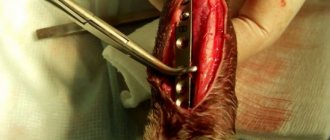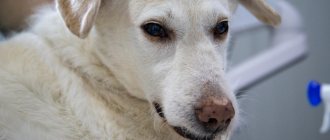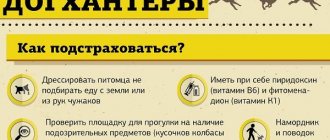Vomiting in a dog is a defense mechanism of the body. It occurs reflexively. There can be many reasons why such an unpleasant sensation occurs. It occurs both as a result of banal poisoning and due to serious disorders in the animal’s body. What dog behavior should you be especially wary of?
Condition preceding vomiting
Unfortunately, our pets cannot speak and it is impossible to understand what they are feeling. This can only be determined by the behavior of the animal and its appearance.
- Typically, vomiting in a dog begins with nausea and the following symptoms:
- The dog licks his lips frequently;
- Does not approach the plate of food or drink water;
- Due to excessive salivation, he constantly swallows saliva;
- The dog is in a restless state, rushing around the rooms, not finding a place for itself;
- The stomach growls;
- Dyspeptic disorders occur: diarrhea or constipation.
Such similar phenomena as vomiting and regurgitation leave animal owners confused. In the second case, food does not reach the stomach, and it is removed from the esophagus. And when vomiting, food is exposed to digestive enzymes, so it looks like a yellow or yellow-green gruel.
Causes
The formation of white foam is a natural process. It occurs as a result of the interaction of mucus, oxygen, and gastric juice. With the help of spasms, the foamy mixture is pushed out.
In the case where a dog vomits once, the vomiting is physiological in nature. There is usually no need to see a doctor.
Main reasons:
- The animal independently tries to get rid of the foreign body. Wool caught in the stomach and small objects eaten are harmful to health. It's better when everything comes out naturally.
- The dog regurgitates the foamy contents when he is very hungry. A lot of gastric juice is produced during the day. If it is not used to digest food, then vomiting occurs.
- Severe stress for a dog provokes nausea. The pet experiences changes in the environment and conditions of care. The animal often gets sick while traveling by car.
- Due to the structure of the digestive tract, white foam vomiting is common in small breeds. The dog's body immediately reacts to changes in the food offered.
- Breeds that salivate excessively produce mucus that can be mistaken for vomit. This occurs due to the structural features of the jaws.
Diseases that cause vomiting
Nausea becomes a sign of illness when the pet's behavior changes. The animal refuses food, is less active, whines, and hides. In addition to this, the dog burps several times a day. To establish the correct diagnosis, you should immediately contact a veterinary clinic. In rare cases, the cost of providing assistance runs into hours.
List of diseases:
- Poisoning from food and chemicals. There is a change in stool, lethargy and refusal to eat. In difficult cases - convulsions.
- Diseases of the digestive system provoke vomiting and diarrhea with blood. These include: gastritis, cholecystitis, intestinal obstruction. The animal feels pain in the abdomen and reacts sharply to touch.
- Rabies is a deadly disease for both dog and owner. Symptoms of the disease are fear of water, paralysis of the respiratory tract, and aggressive behavior.
- Infectious infection occurs with elevated temperature and deterioration of the pet’s condition. Hepatitis and plague lead to depletion of the body and require immediate treatment.
- White foam is a sign of worms. Pests attack the internal organs of the animal and lead to nausea. Appetite usually increases, but weight loss continues.
- Epileptic seizures are accompanied by discharge from the mouth. Seizures occur most often in poodles, labradors and spaniels.
- Heatstroke triggers the gag reflex. The animal may lose consciousness for a short period of time.
- Kidney failure is accompanied by a pungent odor of ammonia from the mouth. Diseases of the genitourinary system require medication.
Preventive actions
We should always remember that we are responsible for those we have tamed. The pet needs the close attention of the owner. The dog must have a regular balanced diet and sufficient walking time at least 2-3 times a day. Prevention of helminthiasis and vaccinations are carried out according to schedule. During walking, the animal should be kept from grabbing and, especially, swallowing pieces, bones, objects, and should not be allowed close to heaps of garbage. Once every 3 months, the dog needs a preventive examination. The animal requires proper care and a clean, dry room.
What to do if your dog is vomiting white foam
Emergency medical care is required when vomiting occurs several times a day and is accompanied by other dangerous symptoms. Drug treatment is prescribed by a veterinarian depending on the severity of the disease. Intravenous drips and vitamin complexes are used to relieve intoxication. You can alleviate your pet's condition at home. To do this, you need to know the rules of first aid.
First aid for vomiting
If you lose consciousness during an attack, you should empty your mouth of vomit. To do this, you need to lay the animal on its side and stick out its tongue. You cannot choke in this position. When the pet comes to its senses, it needs to be put on a starvation diet. It is allowed to give natural broths and cereals. The use of absorbents will help in case of poisoning or infection. The approved drugs will not cause harm, but rather will help alleviate the condition before arriving at the clinic. Sweet solutions will restore the water-salt balance in the body. It is necessary to solder in small portions.
Drinking regime
To avoid intensification of the pathological process, you should follow the drinking regime. The animal should be offered boiled water in limited quantities. You can carefully remove it using a syringe or spoon. The interval should be 1 hour. A large amount of water will irritate the gastric mucosa and cause nausea. In this case, the amount of liquid is reduced, increasing the time between doses. You can alternate water with specialized solutions to restore the water-salt balance.
Dietary recommendations
During illness, the dog’s nutrition must be provided in a gentle manner. The main thing is to provide dietary low-fat food so as not to put a strain on the stomach. Meat purees, porridges, and broths are suitable. In case of severe disease, you can completely refuse food for the first day. After the vomiting stops, they switch to 4-5 meals a day in small portions. If the condition was a sign of poisoning, then specialized food must be given during the recovery period. You can introduce light natural foods into your diet. Treats are limited at first. Bakery products, bones, raw vegetables and fruits should be completely excluded.
Other tips:
- food must be fresh and at the optimal temperature;
- your pet will eat salted food more readily;
- the animal’s eating habits should be taken into account;
- It is recommended to create a schedule to feed by the hour;
- To restore the microflora, it is possible to take medications.
Treating the root cause
After passing all the necessary tests and conducting research, the veterinarian determines the root cause. Further treatment for vomiting with white foam in a dog depends on the diagnosis:
- Foreign bodies
. If manual removal is not possible, an operation is performed.
- Viral infections.
Most infectious diseases are treated with antiviral drugs and antibiotics. Damaged immunity is restored with vitamin complexes and immunomodulators. Only rabies is considered incurable. If it is detected, euthanasia is carried out.
- Poisoning
. The effect of rat or other dangerous poison is suppressed by an antidote.
- Gastrointestinal
diseases
. It is suggested to correct the diet and take medications that reduce the acidity of gastric juice. - Helminthiasis
. The animal is prescribed sorbents and anthelmintics aimed at removing toxins and destroying parasites.
- Epilepsy
. New seizures are suppressed with anticonvulsant therapy. If there is no response to this type of treatment, surgical intervention is possible.
In case of severe exhaustion of the body, the use of IVs is recommended. The animal remains in hospital until the nausea stops and the condition returns to normal. After this, the dog is given to the owner along with recommendations for temporary care and feeding.
Prohibited actions
In order not to harm your dog, you need to know about the actions that you should not do. Otherwise, complications and death are possible.
If your dog is vomiting, do not:
- Choose your own dosage of specialized medications. Only a doctor can make a prescription. Treatment in this case is not effective and even dangerous. Without knowing the exact diagnosis, it is easy to harm the animal’s internal organs.
- Antiemetics with human formulations cannot be given. The medicine is not intended for your pet and will make the situation worse. It is better to ensure rest, drinking regime and consult a doctor.
- There is no need to scold or punish your dog, even if it vomits in the room or on the bed. The animal needs moral support. Seizures are difficult to control, so the pet is not aware of its actions.
- There should be no collar, leash, or muzzle while vomiting. The animal can suffocate and die. The airways should be as clear as possible. For decorative breeds, tight clothing and hair clips should be removed.
- In case of poisoning, it is important that all toxins leave the body. Therefore, they try not to use antiemetic drugs right away. You need to give it time and not hold back the urge.
A pet undergoing home treatment should not be left unattended. Convulsions and loss of consciousness are possible. In this state, the dog can harm itself. You need to monitor his behavior and, if necessary, contact a specialist.
What does the color and nature of vomit indicate?
White mucous discharge is often not a cause for concern. They appear during a protective reflex and help cleanse the body of hair, excess food, and foreign objects. Such vomiting is one-time in nature and does not leave any unpleasant consequences for the dog. There is no need to worry if a nursing bitch regurgitates leftover food. This reflex is due to maternal instinct: in this way, the mother feeds the babies when they grow up or when there is a lack of milk. Serious mechanical damage or a pathological process is indicated by yellow (bilious) discharge, gray or dark mucous, and bloody. Such symptoms cannot be ignored; the help of a specialist is required.
When should you go to the vet?
Medications for treatment are not prescribed independently. The only exception applies to adsorbents. If white foam comes out once, then it is considered a natural process. Thus, the dog gets rid of foreign bodies. When the condition worsens, action must be taken. First aid is provided at home before visiting the clinic.
Veterinarian help is needed:
- In case of an epileptic seizure, a visit to the doctor is mandatory. After the necessary tests, medications will be prescribed to restore the central nervous system.
- If there is a suspicion that your dog has rabies, you should not delay the appointment. The animal must be isolated and, if possible, a veterinarian must be called to the home.
- To administer IV drips intravenously or under the withers, you cannot do without a visit to the hospital. The solutions will help restore water-salt balance, avoid dehydration and relieve intoxication.
- If parasites or blood are found on the white foam, you should immediately show the animal to a doctor. At the appointment, the necessary medications will be selected after examination and diagnosis.
- Diseases caused by the virus are treated with antibiotics and related medications. The dosage is calculated depending on the infection and the weight of the animal.
The physiological process does not require intervention. The animal should be monitored. The pathological condition, depending on the disease, occurs in different ways. The period for full recovery may vary. It is important to notice the problem in time and begin treatment. When properly prescribed, the disease goes away without complications for the animal. To normalize the functioning of the intestines and digestive tract, medications are prescribed after intoxication has been removed. It is necessary to provide the animal with proper care and nutrition. In order to avoid problems, preventive measures are taken. It is important that the dog receives adequate nutrition. Physical activity in the fresh air will strengthen your immune system. A healthy dog will only bring joy to its owner.
Prevention
To avoid unpleasant consequences, it is necessary to prevent the disease in time. The main preventative measure is constant care, regular feeding and attention to pets. In addition, you should adhere to the following recommendations:
- Puppies need to train their vestibular apparatus. To do this, you can pick up your pet and often take it with you on short trips.
- Dogs should not be allowed to eat foreign food on the street or lick garbage or excrement of other animals. You need to make sure that your dog doesn’t accidentally swallow a sharp object while walking. Large dogs should be muzzled when walking. It will help protect your pet from swallowing foreign bodies and toxic substances.
- Monitor foods in your dog's diet. You cannot suddenly change the food or introduce a new product into the diet in large quantities. Food must be carefully checked for freshness.
- Aerosols against lice and fleas should be hidden on the top shelves or in cabinets so that the dog cannot get them and chew them. Detergents and other toxic compounds should be stored in drawers with a handle.
Dogs must be promptly vaccinated at a certified veterinary clinic and dewormed.
Vomiting from a tick in a dog
A tick bite can also cause an animal to vomit. Piroplasmosis is a seasonal spring-autumn disease, the causative agent of which is the protozoan blood parasite Babesia. The single-celled parasite enters the animal's blood through a tick bite and begins to destroy red blood cells. The principle of infecting an animal is very simple:
- the tick awaits its prey in the grass, on tree branches and even on the ground;
- after it has dug into the skin, when it bites, it injects saliva, and with it microscopic parasites - piroplasms (babesia) - enter the bloodstream;
- Parasites multiply in the animal's body, destroying red blood cells.
The incubation period of the disease lasts from 2 days to 2 weeks. Dogs of all breeds and ages suffer from piroplasmosis; young and elderly animals suffer the most. If, along with vomiting foam, your dog develops yellow diarrhea , lethargy, apathy, loss of appetite, rapid breathing, increased body temperature, pale mucous membranes, and urine becomes dark in color, your pet will most likely be prescribed treatment for piroplasmosis. Only a veterinary clinic specialist can make a final diagnosis for your pet based on examination, medical history and test results. Remember, if the dog does not receive treatment, the animal may die 4-5 days after the first symptoms of the disease appear!
Symptoms
The state of nausea causes anxiety in the dog. She may run in circles, sniff and lick the floor, hide under furniture or in a corner. The animal is drooling, although nausea is not necessarily accompanied by vomiting. It is not necessarily a harbinger of disease. The pet can burp several times, protecting the walls from digestion by the stomach itself. This regurgitation often occurs when food is completely digested. You just need to observe your pet before drawing conclusions about a specific disease.
Self-help or a visit to a veterinary clinic?
Of course, you should not self-medicate when your dog is vomiting white foam or blood. The best option would be to give your pet an adsorbent, such as activated carbon, enterosgel or smecta, which will help remove all the dirt from the body.
This applies to cases where the initial symptom is poisoning, but if it is mechanical damage to the walls of the stomach, a virus or more serious diseases, then absorbents will not help; help and treatment from a specialist is necessary.
There is nothing difficult to cope with vomiting due to fasting; for this you need to reduce the temporary breaks in eating. Changing your diet will also have a good effect on your appetite.
If the owner has detected worms in the vomit, then treatment with anthelmintics and medications is prescribed. Typically, treatment occurs in a course taking into account the external characteristics of the animal.
If it comes to an epileptic seizure, then you need to put the pet on its side, supporting its head in weight. Move away things that could injure or injure the dog, as in some cases the convulsions are quite severe. Once the seizures are over (meaning one seizure), you should immediately take the dog to a veterinary clinic. The veterinarian will prescribe anticonvulsants for your pet and prescribe a course of treatment.
Poisoning should be treated with adsorbents. It must be remembered that some of them are not suitable for dogs, so even in case of poisoning, the owner must be careful.
If the dog has received an injury in the mouth or it concerns mild forms of stomatitis, then the wound or damaged area is treated with an antiseptic. In case of delayed treatment, wound-healing drugs and anti-inflammatory drugs are useful.
If there is a risk of contracting rabies, the pet must be isolated and a veterinarian must be called for examination.
Antibiotics, antiviral drugs, and vitamin complexes that support the immune system help well with plague. It is worth remembering that they must also be prescribed by a veterinarian.
Preventing gastrointestinal problems in dogs
Preventive measures aimed at preventing gastrointestinal diseases are divided into nursing and educational. Basic recommendations include:
- Prohibition on picking up garbage. Digging through household trash or street bins can lead to acute poisoning or ingestion of a foreign body. Accustom your pet to prohibition commands from early childhood or give it to a dog handler. At first, you can limit yourself to a muzzle, which prevents picking up dangerous objects.
- Quarterly deworming and annual vaccination. Stay on schedule to prevent these treatments from becoming less effective.
- Accustoming to long trips in transport. Start with short distances and use motion sickness remedies.
- Diet control. Monitor the quality of food, avoid sudden changes in food and overfeeding. Remember that sharp bones can damage the esophagus and intestines.
- Safe storage of medicines and household chemicals. Prevent your pet from having access to the listed substances by placing them in a place inaccessible to him.
Don't ignore any changes in your pet's behavior and attend regular checkups. Timely detection of the problem will eliminate complications and surgical intervention.
The appearance of foamy vomit requires mandatory diagnosis.
Without the help of a veterinarian, it is difficult to figure out the cause on your own, so attempts at home treatment are fraught with aggravation of the pet’s condition. The article is for informational purposes only.
Contact your veterinarian! Do you like the article? 252











